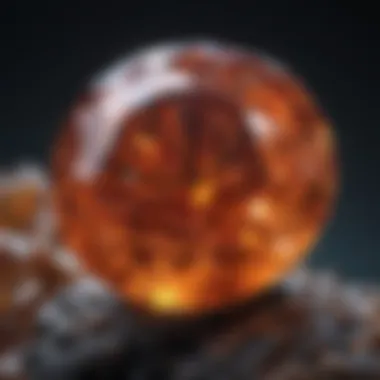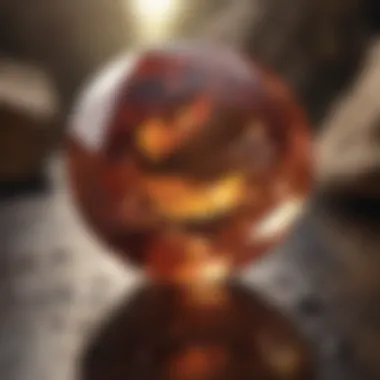Unlocking the Intricacies of Precious Stone Identification: A Deep Dive


Rock and Fossil Identification
Gemstones, hailed for their exquisite beauty and rarity, hold a mystique that transcends time. In the realm of precious stone identification, a meticulous process unfolds wherein gemologists navigate the complexities of discerning and categorizing these coveted treasures. By evaluating a plethora of physical characteristics such as color, clarity, and refractive index under specialized tools 🔬, experts unravel the unique signatures that distinguish one gemstone from another.
Collecting Tips and Techniques
Aspiring gem enthusiasts embarking on the journey of collecting precious stones must heed essential best practices to curate a remarkable collection. From scouting prime collecting sites hidden in remote locales to safely extracting specimens without compromising their integrity, the art of collecting gemstones demands a blend of patience, skill, and reverence.
Preservation and Display
Upon procuring these precious gems, preserving them for posterity becomes paramount. Gemstone aficionados learn the delicate techniques of maintaining the natural allure of these stones, employing proper storage methods that shield them from environmental harm. Furthermore, creative display ideas unfold avenues for showcasing these gems, transforming them into captivating pieces of art that mesmerize beholders.
Geological Insights
Beyond their aesthetic appeal, gemstones hold a geological narrative that sheds light on the Earth's rich history. Exploring the geological formations and processes that birthed these gems unravels a multidimensional perspective. Delving into the historical significance of notable gemstone discoveries unveils the intertwined nature of humanity and Earth's treasures, offering insights that transcend time and space.
Foreword
Understanding the Significance of Precious Stone Identification
The Role of Gemological Knowledge


Gemological Knowledge plays a pivotal role in the realm of precious stone identification, serving as the foundation for accurate gem categorization. Its significance lies in deciphering the intricate details that define one gem from another, enhancing the precision of identification processes. This knowledge base empowers gem enthusiasts and experts to make informed decisions, distinguishing between natural and synthetic stones with unparalleled accuracy, thereby ensuring transparency and reliability in the gemstone market.
Importance in Authenticity Verification
Authenticity verification stands as a cornerstone in the precious stone identification process, guaranteeing the integrity and value of gemstones. By verifying the authenticity of gemstones, practitioners uphold ethical standards and instill trust among consumers and stakeholders. This aspect not only safeguards against counterfeit practices but also preserves the legitimacy and prestige associated with genuine gemstones, emphasizing the crucial need for thorough verification protocols within the gemstone industry.
Overview of the Precious Stone Identification Process
Evaluating Physical Characteristics
Evaluating Physical Characteristics forms the essence of the precious stone identification process, encompassing aspects such as color, clarity, cut, and carat weight. Through meticulous examination of these attributes, gemologists can determine the quality and uniqueness of each stone, facilitating accurate identification and valuation. By mastering the art of evaluating physical traits, enthusiasts can appreciate the distinctiveness of each gemstone, thereby broadening their knowledge and discernment within the field of gemology.
Utilizing Specialized Equipment
Specialized Equipment plays a crucial role in enhancing the precision and efficiency of precious stone identification. From advanced microscopes for in-depth analysis to refractometers and spectrometers for assessing optical properties, these tools provide valuable insights into the inner workings of gemstones. By leveraging state-of-the-art equipment, gem experts can unravel the secrets hidden within each stone, unlocking a world of information that guides them towards accurate gemstone identification and assessment.
Physical Characteristics of Precious Stones
In the intricate realm of precious stone identification, understanding the physical characteristics plays a pivotal role. Evaluating these characteristics provides essential insights into the quality and authenticity of gemstones. From color and clarity to cut and carat weight, each aspect contributes to the overall beauty and value of the gem.
Color
Color is a fundamental aspect when assessing gemstones. In the realm of assessing hue, tone, and saturation, color plays a crucial role. The hue represents the basic color of the stone, the tone indicates the lightness or darkness of the hue, while saturation refers to the intensity of the color. Understanding these intricacies is vital in determining the rarity and value of a gem. It is a popular choice for gemologists due to its direct impact on the aesthetics and desirability of the stone.


Clarity
Another critical factor in identifying precious stones is clarity. Evaluating inclusions and blemishes is imperative as it affects the stone's transparency and overall beauty. The presence of blemishes can diminish the value of a gem, whereas high clarity without visible inclusions enhances its allure. Balancing clarity with other characteristics is essential in achieving a well-rounded assessment of the stone.
Cut
Examining proportions and facets is an art form in the world of precious stones. The cut of a gem influences its brilliance, fire, and overall appeal. A well-cut stone reflects light in a mesmerizing way, enhancing its visual impact. However, a poorly cut gem may appear dull and lackluster, reducing its value. Understanding the nuances of cut is indispensable when determining the quality of a precious stone.
Carat Weight
Weighing and measuring gemstones provide crucial information about their size and density. Carat weight directly influences the rarity and price of a stone, with larger gems typically commanding higher values. Balancing carat weight with other factors like cut and color is vital in gauging the overall worth of a gem. While a larger carat weight may seem desirable, it is essential to consider all aspects to make an informed evaluation.
Advanced Tools for Precious Stone Identification ###Advanced Tools for Precious Stone Identification play a pivotal role in enhancing the accuracy and efficiency of gemstone identification processes 🔎. These tools encompass various specialized equipment that aids gemologists in evaluating gemstones with precision and clarity. From microscope analysis to refractometer and spectroscope, each tool offers unique insights into the composition and characteristics of precious stones. The utilization of advanced tools is crucial in differentiating between natural and synthetic gemstones, as well as identifying treatments or enhancements applied to the gems. Gemologists rely on these tools to provide clients with accurate assessments and ensure authenticity in the gemstone market.Within the realm of advanced tools for precious stone identification, Microscope Analysis stands out as a fundamental technique for gemstone evaluation. By enhancing the visibility of inclusions, gemologists can delve deep into the internal structure of gemstones to identify unique characteristics and attributes 🔬. The process of enhancing visibility of inclusions enables gemologists to distinguish between natural imperfections and potential treatments, contributing significantly to the overall accuracy of gemstone identification. This meticulous examination helps in determining the origin, authenticity, and quality of gemstones with precision and confidence.Refractometer and Spectroscope are indispensable tools in the gemological toolkit, focusing on measuring refractive index and spectral patterns of gemstones 🌈. By analyzing how light interacts with the gemstone, gemologists can determine key properties such as double refraction, pleochroism, and absorption spectra. These measurements provide invaluable data for identifying gemstone types, as different gemstones exhibit distinct refractive indexes and spectral signatures. The use of refractometer and spectroscope enhances the precision and scientific rigour in gemstone identification processes, ensuring accurate results and reliable gemstone evaluations.In the realm of Specific Gravity Testing, determining gemstone density plays a crucial role in gemstone identification and differentiation. This method involves comparing the weight of the gemstone in air to its weight in water, calculating the density with high accuracy ⚖️. Gemologists utilize specific gravity testing to distinguish between gemstone imitations and synthetics by assessing variations in density. Understanding the unique density characteristics of gemstones assists gemologists in verifying gemstone authenticity and detecting potential treatments or alterations. Specific gravity testing adds a layer of certainty to the gemstone identification process, providing concrete data for informed evaluations and assessments.
Common Mistakes in Precious Stone Identification
Gemstone identification holds a pivotal role in the world of jewelry and gemology. The realm of precious stones is rich in diversity and complexity, making the task of identifying them accurately a challenging endeavor. Within this article, the discussion on common mistakes in precious stone identification is essential as it sheds light on pitfalls that gemologists and enthusiasts need to navigate carefully. By understanding these mistakes, individuals involved in gemstone assessment can enhance their accuracy and precision, ensuring that they do not misclassify valuable stones or overlook crucial factors that affect a gem's authenticity and value.
Misjudging Synthetic Stones as Natural
When delving into the aspect of identifying lab-created gemstones, one encounters a fascinating dimension of the gemstone world. Lab-created gemstones present a unique challenge in discerning them from natural counterparts due to the advanced techniques used in their synthesis. The key characteristic of identifying lab-created gemstones lies in scrutinizing their growth patterns and inclusions, which often differ from those found in naturally occurring gems. This facet is crucial in the context of this article as it highlights the importance of being able to differentiate between lab-created and natural gemstones to avoid misrepresentations and ensure transparency in gemstone transactions.
In contrast, distinguishing treatment enhancements is another critical aspect of gemstone evaluation, especially concerning color and clarity enhancements. Identifying the specific treatments done on gemstones requires a keen eye and specialized knowledge to detect enhancements such as heat treatments, irradiation, or coating. This section significantly contributes to the overarching goal of this article by emphasizing the need to assess gemstones for any treatments they have undergone accurately. Understanding these treatments is vital as they can influence a stone's durability, appearance, and value, making it imperative for gemologists to make informed decisions based on this information.


Overlooking Rarity and Value Factors
In the realm of precious stones, overlooking rarity and value factors can lead to undervaluing or overestimating the worth of a gem. Evaluating uniqueness and market demand plays a crucial role in gauging the true value of a gemstone. The key characteristic of this aspect lies in assessing the scarcity of a particular gem type, its desirability in the market, and the trends influencing its value over time. This evaluative process is paramount for individuals engaging with gemstones, as it enables them to make informed decisions regarding their acquisition or sale.
Furthermore, understanding the dynamics of market demand helps in staying abreast of shifting preferences and consumer behaviors, aligning one's collection or inventory with prevailing trends. However, a potential disadvantage of focusing solely on market demand is overlooking the intrinsic qualities of a gemstone that make it truly exceptional. Balancing market trends with the inherent rarity and beauty of a gemstone is a delicate dance that individuals in the gem trade must master to navigate successfully, ensuring that they appreciate and value each stone for its unique attributes.
Emerging Trends in Precious Stone Identification
As we delve deeper into the realm of precious stone identification, it becomes imperative to explore the emerging trends shaping this fascinating domain. The evolution of technology and industry practices introduces a new dimension to the age-old art of identifying gemstones, offering unprecedented levels of precision and authenticity in this meticulous process.
Blockchain Technology for Gemstone Traceability
Within the landscape of precious stone identification, the integration of blockchain technology stands out as a monumental advancement. By focusing on enhancing transparency in the supply chain, blockchain revolutionizes the way gemstones are traced from their origins to market distribution, instilling a newfound sense of trust and accountability.
Enhancing Transparency in the Supply Chain
The pivotal element of enhancing transparency in the supply chain lies in its ability to provide an immutable record of each gemstone's journey. This feature ensures that the lineage of a precious stone, from its extraction to its sale, remains unaltered and verifiable. The benefit of such transparency is paramount, as it safeguards against fraud, counterfeit practices, and unethical sourcing within the gemstone industry.
Moreover, the unique feature of real-time tracking and authentication empowered by blockchain technology offers a level of security and confidence previously unparalleled. However, like any innovative solution, challenges such as data privacy concerns and regulatory compliance must be navigated to fully leverage the advantages of enhancing transparency in the supply chain.
Artificial Intelligence in Gemstone Recognition
Another revolutionary trend in precious stone identification is the integration of artificial intelligence (AI) to automate identification processes. Harnessing the power of machine learning algorithms, AI streamlines the categorization and appraisal of gemstones with unmatched speed and accuracy, setting a new standard in efficiency and reliability.
Automating Identification Processes
At the core of AI's impact on gemstone identification is the automation of complex recognition protocols. By swiftly analyzing vast datasets and patterns, AI algorithms can identify gemstones based on predetermined criteria, reducing human error and subjectivity. This feature not only expedites the identification process but also enhances the consistency and precision of results, catering to the demands of a fast-paced industry.
The key characteristic of AI-driven gemstone recognition is its adaptability and scalability, making it an increasingly popular choice for those seeking optimized workflows and enhanced productivity in precious stone identification. Despite its numerous advantages, including increased efficiency and reduced labor costs, the implementation of AI in gemstone recognition requires careful fine-tuning to ensure seamless integration and alignment with traditional expertise.







